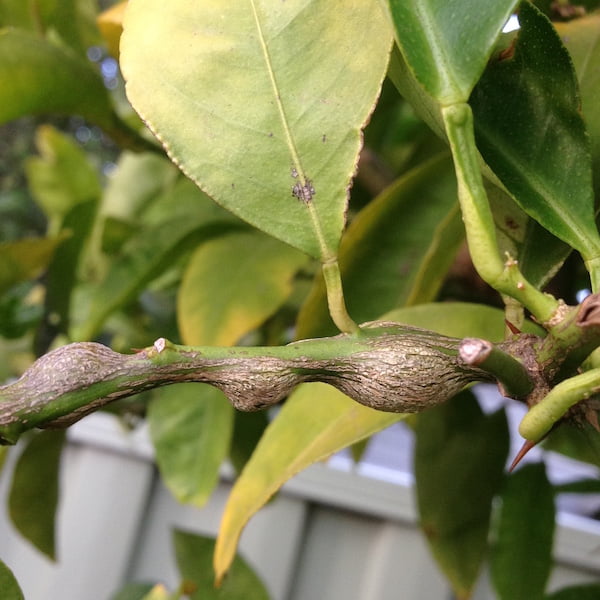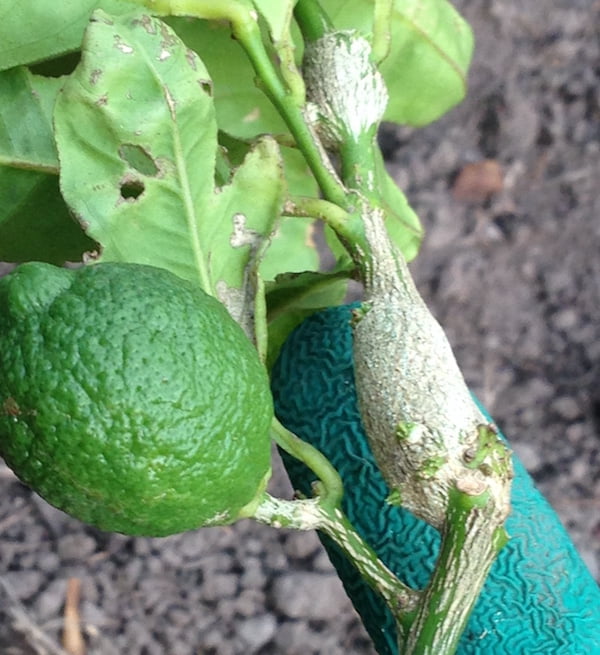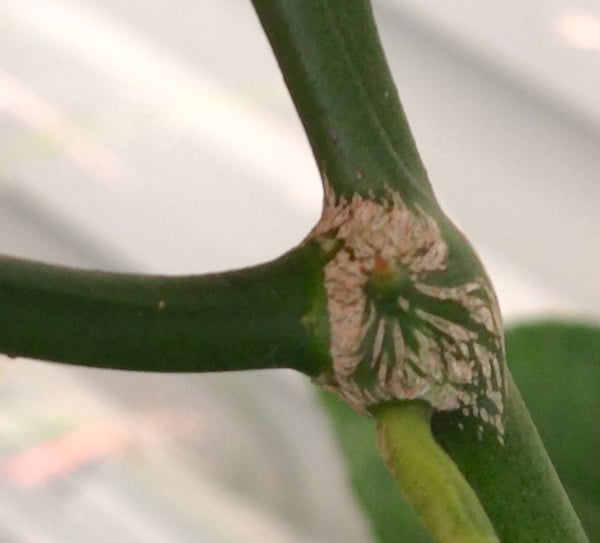It’s hard to imagine a backyard without a good old heritage lemon tree in the corner to make spontaneous lemonade or a delicious lemon meringue pie for dessert. But right across Melbourne and into Victoria, that’s the future we’re now facing as our citrus trees are under serious threat, slowly dying from a pest so tiny you can’t see it easily – the citrus gall wasp (Bruchophagus fellis).

Citrus stem showing the tell-tale bumps caused by citrus gall wasp
Unlike a lot of our more severe pests this one’s a native, originating in Queensland with the Australian native finger lime being its favourite food.
Since the 1990s as the climate has warmed it’s been following the fruit growing routes, finally finding the oasis of Melbourne’s backyard citrus trees. As these trees are all growing just over the fence from each other in our suburban backyards, they make a convenient stepping stone for the gall wasps to spread right across the city.
However the citrus gall wasp doesn’t just stick to the old lemon tree. It also enjoys snacking on grapefruit, orange, lime, even cumquats…anything citrus is on the menu.
Compounding the problem is that the citrus gall wasp has a sneaky 12 month life cycle. In spring the tiny adult (at 3mm long) flies or is blown along by the wind. Once it lands on a juicy new stem it injects its eggs straight under the bark. The tree reacts by forming the distinctive swelling known as a ‘gall’ so that its nutrients and water can continue to flow up the stem.

Gall with immature lemon
Sometimes the tree puts on fruit at the ends of these branches. This is a survival mechanism as the tree tries to spread its next generation of seedlings and, while the fruit is not affected, over time the tree’s fruit will become smaller and reduce in quantity. Eventually the tree will stop flowering all together when it can no longer cope with the infestation.
Within the safety of their gall homes the wasps munch away at the soft new tissue until they pupate into adults and, in the next early spring when warm they punch out, leaving the tell-tale pin prick marks of an old gall. They quickly reinfect the tree and then fly off to do the same to the neighbour’s tree. Nitrogen fertilizers in spring can exacerbate this by excessive new growth which attracts a flurry of hungry wasps.

Old gall – and new gall. I have removed the cambium layer on the stem so you can see the gall wasp eggs inside
The good news is this is one pest where we can all do something about it. Co-ordinated, timely pruning and disposal can have an impact on reducing the damage. BUT it requires the community to prune together and dispose of the infected material properly all before the spring reinfection.
Because even if you are doing the right thing at the right time, if you peek over the fence and see that your neighbour isn’t, then the citrus gall wasp will continue to survive, especially as each gall can have up to 20 or more tiny eggs inside.

A gall intersection where the tree has sent out another shoot to cope with the reinfection
The Save our Citrus Melbourne campaign was set up after I discovered there’s a whole lot of backyard trees in dire need of our help, as well as a lot of misinformation on how to tackle this pest. As founder of the campaign I regularly post maintenance hints and tips and upcoming talks on the Save Our Citrus Melbourne Facebook page, and this is helping to keep people up to date.
 The Facebook page is also a place for people to connect and share information and I have been heartened by the number of citrus lovers out and about in our city.
The Facebook page is also a place for people to connect and share information and I have been heartened by the number of citrus lovers out and about in our city.
So far the campaign has produced an easy to follow pruning brochure available that you can download or give to your neighbours so that people can make these connections and discuss this problem. This is especially important because there may be people who have bought an older house and at the same time inherited a gall infected tree and don’t know what to do.
The next big thing for the Save Our Citrus Melbourne campaign will be a crowd funding campaign to try to raise enough funds to get brochures developed in different languages, produce some citrus gardening care videos, hire more venues for a series of Save our Citrus Melbourne talks in July to get people prepared and informed.
It’s great that there’s this ongoing trend of people wanting to plant-out productive gardens but what’s missing is the knowledge on how to care for these plants and trees so that people can identify what pests and diseases to look for and confidently care for their productive gardens, keeping them in shape for future Melbourne gardeners.
How to prune out your citrus galls:
• First cut 2cm below the infected area. Prune out active galls out as they appear.
• Where possible cut through the galls exposing the wasps to oxygen.
• Put the material into a bin filled with water and let the infected material rot down for at least two weeks so that the eggs are drowned.
• If you are able to, incinerate the material but check with your Council first.
• Don’t put the material in your green waste – instead put the material in garbage bags with no holes and dispose of it in your bin.
